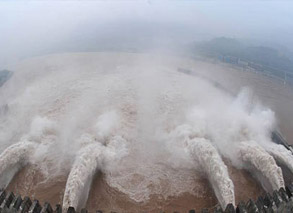China faces energy challenges in switch to low-carbon economy
2010-04-12 10:18 BJT
BEIJING, April 12 -- China has made significant efforts to pursue energy and resource efficiencies to achieve sustainable development, while the nation still faces challenges in the transition to a low-carbon economy and needs integrated solution systems.
"China is already a world leader in critical low-carbon technologies such as solar power, heat and wind turbines, however, it should do more in some key areas, including energy systems, transport, water and food supply during the transformation," said Bjorn Stigson, president of the World Business Council for Sustainable Development (WBCSD), a coalition of some 200 companies dealing exclusively with business and sustainable development.
Challenges
Changing energy use is the biggest of China's challenges when transforming to a green economy. "Less oil, more renewable energy; less coal, more electricity," said Stigson, adding that China's explosive industrial development has placed great pressure on the consumption of energy and other resources.
The large share of coal in China's energy mix is one reason why greenhouse gas emissions have climbed so sharply in recent years, though the government has invested heavily in the recycled energy sector.
"It (China) added more new wind power capacity than any other country last year and progress is on track for nearly 40 million households to use biogas by 2010," he said.
Stigson indicated that driving up the efficiency of older power stations is a key part of the solution so far, as are opportunities to switch to natural gas and upgrade the transmission grid - but a rapid increase in the share of renewable energy and nuclear power in the coming decades will be essential.
He added that another benefit of the change is that China can soon become a new energy products and services exporter in the near future.
Transportation is another pillar as the transport sector is the largest and fastest-growing global emitter of CO2. Currently, about 70 percent of China's energy is used by industry, and only about 10 percent as fuel for its transportation needs, but car ownership is growing daily in China, and energy consumption and emissions are likely to increase significantly in the coming years.
"Fortunately, the government has put fuel efficiency limits on cars, which are tougher than those in the United States, but more is needed to promote hybrid and electric cars," said Stigson
Water is also crucial, which was highlighted by the current severe drought in southwestern China. Increasing the efficiency of water resources is a tough task for China.
In addition, food supply cannot be ignored. As a food security measure, China's 11th Five Year Plan (2006-10) set a minimum land area of 122 million hectares for grain production in China by 2020. Keeping above this level is an increasingly difficult challenge, given the impact of climate change and rapid urbanization in China.
"Further improving water and land management practice will be key to maximizing potentials and minimizing the impact on the environment, but this is a significant challenge," said Stigson.
Solutions
All of the challenges should be tackled under an integrated solution system, in which government will play a major role in terms of policy formulation and coordination, emphasized Stigson, who is a member of the China Council for International Cooperation on Environment and Development, a high-level advisory body conducting research and providing policy recommendations to the Chinese government. He is also co-chair of the body's Low Carbon Economy Task Force.

 Mail
Mail Share
Share Print
Print


 Video
Video









 2009 China Central Television. All Rights Reserved
2009 China Central Television. All Rights Reserved